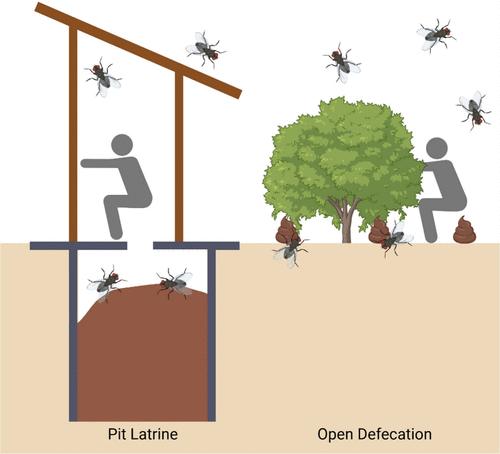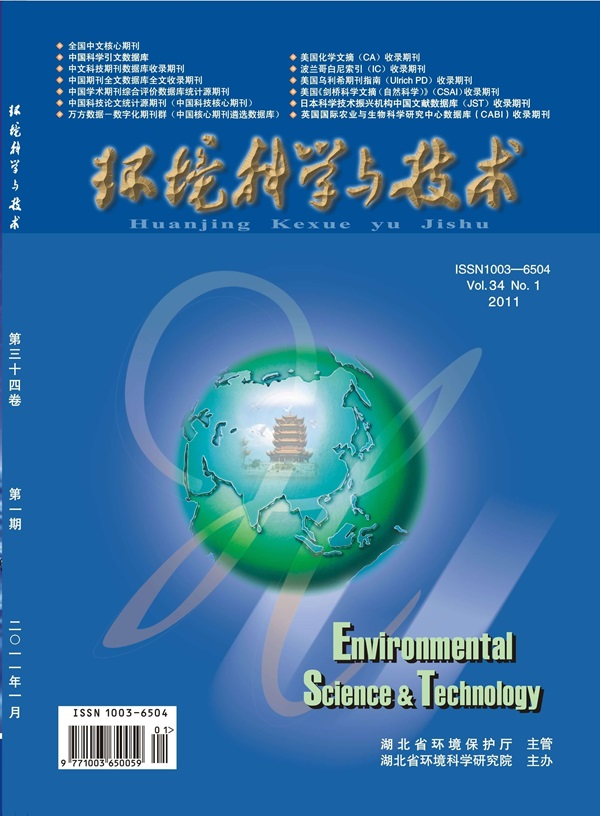Buzzing Beyond Annoyance: Flies as Nature’s Composite Samplers of Terrestrial Fecal Contamination
IF 10.8
1区 环境科学与生态学
Q1 ENGINEERING, ENVIRONMENTAL
引用次数: 0
Abstract
While eating a meal outside or in your kitchen, the presence of flies incessantly buzzing around is common. Not only annoying, flies pose a public health hazard. (1,2) Some flies–including house flies and blow flies–consume feces as part of their diet. This fecal material contains trillions of microbes, which may include pathogens and antibiotic-resistant organisms. Flies carry pathogens two ways: physically attached to their body as they land on the feces, and inside their alimentary canal. When a fly lands on any surface following a meal (which could include the chicken and rice you are planning to eat for dinner), it may vomit. This fly “speck” may be composed of fecal remnants that contain pathogenic organisms. Flies also defecate, and many pathogens can survive passage through the fly alimentary canal. (1) The consumption of these pathogens by humans can lead to an infection, which is a prerequisite for illnesses such as diarrheal disease. The same behavior that causes flies to pose a public health risk also creates a unique opportunity for environmental monitoring. Certain species of flies–including blow flies and house flies–can be viewed as nature’s composite samplers of fecal material in the terrestrial environment. Environmental samples are typically collected via grab, passive, or composite sampling. (3) Grab samples are discrete samples collected from a single location and time-point. Passive samples require a material that spontaneously absorbs or adsorbs the contaminant of interest from the surrounding environment. Composite samples are mixtures of multiple individual samples which may be pooled geographically or temporally. Combining samples to form a composite sample may provide a more representative understanding of the target of interest in a population but loses information about individual samples. Composite sampling is also used because it can dramatically reduce analytical costs via a reduction in the number of analyses required. Methods for composite sampling are well developed for air, water, and soil monitoring, as well as for clinical testing. (3) Natural fly behavior mimics that of a composite sampler (Figure 1). Flies continuously move from attractant to attractant during daytime hours, feeding on a variety of organic material that includes feces for some species. (1,2) Through ingestion, or attachment to the body surface, flies gather microbes and chemicals present in the terrestrial locations they visit, effectively creating a composite sample. While flies are capable of up to 20 km of flight in a single day, long-distance travel is rare when nearby food is plentiful. (1,2) Instead, flies will often travel less than a few hundred meters in a single day, indicating that they may be used as composite samplers of the localized terrestrial environment. Figure 1. Flies move from attractant to attractant, collecting fecal microbes on their outer body and in their alimentary canal. Fecal material contains a wealth of information about the individuals and populations that generate it. Testing pooled feces via wastewater-based monitoring for analytes of interest has been used since the early 1900s and became widespread during the COVID-19 pandemic. (4) While effective for public health surveillance, many communities lack these aquatic matrices (e.g., a piped wastewater system or drainage canals that receive fecal wastes). Some examples include rural communities in the United States who use septic tanks or communities in low- and middle-income countries reliant on onsite sanitation such as pit latrines. Flies could also be used to monitor analytes of interest in low-income communities or animal populations that openly defecate in the environment. Monitoring this terrestrial fecal contamination could provide actionable information to public health officials or other stakeholders in these communities of interest. Potential use cases include advanced warning about emerging and re-emerging infectious diseases, monitoring antimicrobial resistance, or for fecal source tracking to identify the primary contributors to terrestrial fecal contamination. Flies also collect chemicals from the environment and can be used to sample contaminants from areas that are inaccessible or unsafe for humans to visit. (5) Similar to other environmental matrices, the potential for microbes to remain viable while being carried by flies is influenced by environmental conditions. Desiccation, especially on the external fly body, can inactivate microbes. After ingestion, microbial survival is affected by varying pH levels along the alimentary canal, though the effects of temperature and humidity on microbial persistence within the fly gut is unclear. Warmer temperatures and higher humidity likely result in greater food intake by flies, yet warmer temperatures may also accelerate microbial decay compared to cooler temperatures. Species of flies vary across regions and ecosystems, yet they share common behaviors: they seek out water, carbohydrates, protein sources, and sites suitable for egg-laying. Species have distinct ecological niches, feeding habits, and preferences, (1) which can be leveraged for targeted sampling. Blow flies, for example, can be easily and almost instantaneously attracted to a baited trap containing strong-smelling materials. (6) Many other fly species, such house flies, are readily collected with baited or sticky traps that are left in the environment over a period of time. The combination of this ease of capture and fly behaviors results in rapid and scalable methods that allow flies to serve as nature’s composite samplers of feces in the terrestrial environment. Other insects share similar behaviors and may also act as natural samplers. Bees collect pollen while foraging and bring this mixture back to their hive. Some species of beetles and cockroaches consume fecal material and may form a composite sample of their feeding sites. Alternatively, earthworms may act as passive samplers through bioaccumulation of soil-based contaminants from their burrowing and feeding habits. Despite the many benefits of using flies as natural composite samplers, there are also limitations to this approach. One limitation is that flies are opportunistic feeders, and their movements are influenced by the availability of food and breeding sites. As a result, the analytes they carry may represent the specific microenvironments they frequent and not the broader environment. In addition, flies are poikilotherms, meaning that they cannot regulate their body temperature except by behavioral means. (1,2) This means that flies are only present in the warmer spring, summer, and fall months in the higher latitudes and do not survive in extreme environments (e.g., the poles and at high elevations). However, flies can often be found year-round in warm tropical environments. Flies, despite their reputation as pests, serve a unique role as nature’s composite samplers of fecal material. We can leverage this behavior to advance our understanding of the pathogens and other analytes present in fecal material in the terrestrial environment. Improved monitoring could help inform investment and decision making to achieve Sustainable Development Goal 6, which aims for universal coverage of adequate and equitable water and sanitation infrastructure by 2030. This work was supported by the National Science Foundation (Award # 2412444). Drew Capone is an Assistant Professor in the Department of Environmental and Occupational Health in the School of Public Health at Indiana University-Bloomington. He developed an interest in water, sanitation, and hygiene (WASH) while serving in rural Mozambique as an Education Volunteer with the United States Peace Corps (2014-2016). Since 2017 Drew has partnered with researchers at the Mozambique National Institute of Health on WASH research and he has built additional collaborations to investigate WASH challenges in the United States and in low-income countries. Drew’s research uses tools from engineering, epidemiology, and environmental microbiology to investigate the problems affecting low-income individuals and aims to improve public health in the communities where these people live. He loves training his students to catch and analyze flies and he is excited to use flies as composite samplers in future projects. This article references 6 other publications. This article has not yet been cited by other publications.

嗡嗡声超越烦恼:苍蝇作为自然的陆地粪便污染的复合采样器
当你在外面或厨房吃饭时,苍蝇不停地飞来飞去是很常见的。苍蝇不仅令人讨厌,还会危害公众健康。一些苍蝇——包括家蝇和吹蝇——把粪便作为它们的一部分食物。这种粪便含有数万亿微生物,其中可能包括病原体和耐抗生素生物。苍蝇以两种方式携带病原体:当它们降落在粪便上时附着在它们的身体上,以及在它们的消化道内。当苍蝇在吃完饭(可能包括你计划晚餐吃的鸡肉和米饭)后降落在任何物体表面时,它可能会呕吐。这种苍蝇“斑点”可能由含有致病生物的粪便残留物组成。苍蝇也排便,许多病原体可以通过苍蝇的消化道存活。人类食用这些病原体可导致感染,这是腹泻等疾病的先决条件。导致苍蝇构成公共健康风险的同样行为也为环境监测创造了独特的机会。某些种类的苍蝇——包括吹蝇和家蝇——可以被看作是陆地环境中自然界粪便物质的复合采样者。环境样品通常通过抓取、被动或复合采样收集。(3) Grab样本是指从单个地点和时间点采集的离散样本。被动样品需要一种能自发地从周围环境中吸收或吸附感兴趣的污染物的材料。复合样品是多个单独样品的混合物,可以在地理上或时间上汇集。将样本组合起来形成一个复合样本可以提供对总体中感兴趣的目标的更具代表性的理解,但会丢失有关单个样本的信息。还使用复合采样,因为它可以通过减少所需的分析次数来显着降低分析成本。用于空气、水和土壤监测以及临床试验的复合采样方法已经得到了很好的发展。(3)天然苍蝇的行为模拟了复合采样器的行为(图1)。苍蝇在白天不断地从一个引诱剂移动到另一个引诱剂,以各种有机物质为食,其中包括一些物种的粪便。通过摄取或附着在身体表面,苍蝇收集它们所访问的陆地上的微生物和化学物质,有效地制造了一个复合样品。虽然苍蝇一天能飞行20公里,但当附近食物充足时,长途飞行是罕见的。(1,2)相反,苍蝇通常在一天内飞行不到几百米,这表明它们可能被用作局部陆地环境的复合采样器。图1所示。苍蝇从一个引诱剂移动到另一个引诱剂,在它们的体外和消化道中收集粪便微生物。粪便中含有大量关于产生粪便的个体和种群的信息。自20世纪初以来,通过基于废水的监测来检测汇集的粪便,并在2019冠状病毒病大流行期间广泛使用。(4)虽然对公共卫生监测有效,但许多社区缺乏这些水生基质(例如,管道废水系统或接收粪便废物的排水渠)。一些例子包括美国的农村社区使用化粪池,或低收入和中等收入国家的社区依赖于坑式厕所等现场卫生设施。苍蝇也可以用来监测低收入社区或在环境中公开排便的动物种群的分析物。监测这种陆地粪便污染可以为公共卫生官员或这些感兴趣社区的其他利益攸关方提供可采取行动的信息。潜在的用例包括对新出现和再出现的传染病发出预警,监测抗菌素耐药性,或追踪粪便来源,以确定陆地粪便污染的主要来源。苍蝇还从环境中收集化学物质,并可用于从人类无法进入或不安全的地区取样污染物。(5)与其他环境基质类似,苍蝇携带的微生物保持活力的潜力受到环境条件的影响。干燥,特别是外部蝇体的干燥,可以使微生物失活。摄入后,微生物的存活受到消化道内不同pH值的影响,尽管温度和湿度对苍蝇肠道内微生物持久性的影响尚不清楚。较高的温度和湿度可能会导致苍蝇摄入更多的食物,但与较低的温度相比,较高的温度也可能加速微生物的腐烂。 苍蝇的种类因地区和生态系统而异,但它们有共同的行为:它们寻找水、碳水化合物、蛋白质来源和适合产卵的地点。物种有不同的生态位、摄食习惯和偏好,(1)这可以用于有针对性的采样。例如,吹蝇可以很容易地几乎立即被含有强烈气味材料的诱饵陷阱吸引。(6)许多其他种类的苍蝇,如家蝇,很容易用带饵或粘饵的捕蝇器捕获,这些捕蝇器在环境中放置一段时间。这种易于捕获和苍蝇行为的结合导致了快速和可扩展的方法,使苍蝇能够在陆地环境中作为自然的粪便复合采样器。其他昆虫也有类似的行为,也可能是天然的样本。蜜蜂在觅食时收集花粉,并将这种混合物带回蜂巢。某些种类的甲虫和蟑螂消耗粪便材料,并可能形成它们进食地点的复合样本。另外,蚯蚓也可以作为被动采样者,通过其挖洞和取食习惯的土壤污染物的生物积累。尽管使用苍蝇作为天然复合采样器有许多好处,但这种方法也有局限性。其中一个限制是,苍蝇是机会性捕食者,它们的活动受到食物和繁殖地点的影响。因此,它们携带的分析物可能代表它们经常出现的特定微环境,而不是更广泛的环境。此外,苍蝇是变温动物,这意味着它们只能通过行为手段来调节体温。(1,2)这意味着在高纬度地区,苍蝇只在温暖的春季、夏季和秋季出现,在极端环境(如极地和高海拔地区)中无法生存。然而,在温暖的热带环境中,全年都能找到苍蝇。苍蝇,尽管被认为是害虫,但作为自然界粪便材料的复合采样者,却扮演着独特的角色。我们可以利用这种行为来提高我们对陆地环境中粪便中存在的病原体和其他分析物的理解。改善监测有助于为投资和决策提供信息,以实现可持续发展目标6,该目标旨在到2030年实现充分和公平的水和卫生基础设施的普遍覆盖。这项工作得到了国家科学基金(奖励# 2412444)的支持。德鲁·卡彭(Drew Capone)是印第安纳大学布卢明顿分校公共卫生学院环境与职业健康系助理教授。2014-2016年,他作为美国和平队的教育志愿者在莫桑比克农村服务期间,对水、环境卫生和个人卫生(WASH)产生了兴趣。自2017年以来,德鲁与莫桑比克国家卫生研究所的研究人员合作开展了WASH研究,并建立了额外的合作关系,以调查美国和低收入国家的WASH挑战。德鲁的研究使用了工程学、流行病学和环境微生物学的工具来调查影响低收入人群的问题,旨在改善这些人居住的社区的公共卫生。他喜欢训练他的学生捕捉和分析苍蝇,他很高兴在未来的项目中使用苍蝇作为复合采样器。本文引用了6个其他出版物。这篇文章尚未被其他出版物引用。
本文章由计算机程序翻译,如有差异,请以英文原文为准。
求助全文
约1分钟内获得全文
求助全文
来源期刊

环境科学与技术
环境科学-工程:环境
CiteScore
17.50
自引率
9.60%
发文量
12359
审稿时长
2.8 months
期刊介绍:
Environmental Science & Technology (ES&T) is a co-sponsored academic and technical magazine by the Hubei Provincial Environmental Protection Bureau and the Hubei Provincial Academy of Environmental Sciences.
Environmental Science & Technology (ES&T) holds the status of Chinese core journals, scientific papers source journals of China, Chinese Science Citation Database source journals, and Chinese Academic Journal Comprehensive Evaluation Database source journals. This publication focuses on the academic field of environmental protection, featuring articles related to environmental protection and technical advancements.
 求助内容:
求助内容: 应助结果提醒方式:
应助结果提醒方式:


